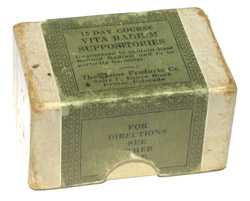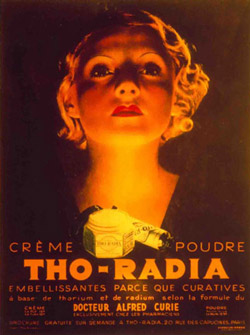
Weak Discouraged Men!
Now Bubble Over with Joyous Vitality Through the Use of Glands and Radium
“. . . properly functioning glands make themselves known in a quick, brisk step, mental alertness and the ability to live and love in the fullest sense of the word . . . A man must be in a bad way indeed to sit back and be satisfied without the pleasures that are his birthright! . . . Try them and see what good results you get!” (Vita Radium Suppositories are shipped in a plain wrapper for confidentiality.)
Who needs Viagra? Just irradiate yourself and tell the wife to watch out. Or so the Home Products Company of Denver, Colorado, advertised in the 1930s. I don’t know about you, but the thought of a radioactive suppository makes me a bit squeamish. In the first half of the twentieth century, however, people felt differently.
For thousands of years, hot springs have been acclaimed for their healing powers. In the early 1900s, scientists discovered that the water was at least slightly radioactive at most of the sites. Ipso facto, radioactivity was a curative. An onslaught of radioactive consumer products followed, and people by the thousands lined up to buy them. Like the patent medicines that preceded them, most of these products were not developed by doctors or clinically tested, but were instead designed by businesspeople to take advantage of the craze.
It seems ridiculous today, given what we know about the harmful effects of radiation, but like so many other “miracle cures,” the enthusiasm for the product overshadowed sometimes devastating results. Compounding the problem was the fact that low-level radiation takes time to destroy a living organism. Not many people, including doctors, associated drinking water from a uranium-lined water cooler for five years with the leukemia that developed fifteen years later.
One would think that the atomic bombs dropped over Hiroshima and Nagasaki would have cured our taste for radioactive products, but the consumer craze continued into the 1950s, and even today you can find the occasional radioactive curative in stores around the world, though not, at least not that I am aware, in the United States. (But hey, fifty years ago, we were selling radioactive laboratory play sets for children.)
Some of my favorite historical cures (besides the suppositories, which take the cake):
Radiothor (1910s)—A wildly-successful product, with about 400,000 bottles sold, Radiothor was triple-distilled water containing at least one microcurie of two different radium isotopes. It was advertised to cure stomach cancer and mental illness, as well as restore “vigor and vitality” (a common theme of radium curatives). Eben Byers, a well-known playboy/industrialist, was a three-bottle-a-day man. When he died a gruesome death from radiation poisoning in 1932, the Wall Street Journal ran an article entitled, “The Radium Water Worked Fine until his Jaw Came Off.”
Radium Water Jars/The Revigator (1910s)—A radium- or uranium-lined water cooler. “The millions of tiny rays that are continuously given off by this ore penetrate the water and form this great HEALTH ELEMENT—RADIO-ACTIVITY. All the next day the family is provided with two gallons of real, healthful radioactive water . . . nature’s way to health.” This company recommended a daily minimum of six large glasses.
Degnen’s Radioactive Eye Applicator (1910s)—Created by M.L. Degnen, the inventor of the Radio-Active Solar Pad, this product, which looks like a pair of wire-rim glasses with opaque lenses, was available in three strengths, and was advertised to cure headaches and difficulty in focusing, as well as “nearsight, farsight, and oldsight.” It was recommended that the user close his eyes when using the applicator.

Radium Bread (1920s)—Baked by the Hippman-Blach Company in what is now the Czech Republic, this bread was made with radium-enriched water. Yum, Yum!
Tho-Radia Face Cream (1930s)—Popular in France, Tho-Radia made a full line of beauty products and perfumes containing both thorium chloride and radium. Is your skin dull? Listless? Want a little shine? Try Tho-Radia! The man the company claimed invented the product line, Doctor Alfred Curie, was not a member of the famed Curie family, nor was he even likely a real person.
The Scrotal Radioendocrinator (1930s)—My second-favorite product. For a mere $150, you could purchase this gold-plated device, filled with radium, which you would place over your endocrine glands (for men they specified under the scrotum) overnight, for improved endocrine health. The inventor, William Bailey, claimed to have drunk more radioactive water than any living man. He died in 1949 of bladder cancer. (Rimshot.)
These companies had the cure for what ailed you. Unfortunately, no one had a cure for the cure. It’s easy today, a hundred years later, to laugh at the idea of these curatives. But I guarantee you that people in the 1910s laughed at the ridiculous products that were used a hundred years earlier. What scares me is that a hundred years from now people will be laughing at the harmful products you and I use today.
Which ones, do you think?

Yikes and wow! If there’d been interesting facts like these in my history classes, I would have paid way more attention!
You know, I feel the same way. They could totally have intrigued me into discussions of history if they’d used this kind of tactic!
I believe every day this is happening with pharmaceuticals.
Of course there will be a lot of jesting about what we name and then rename certainexcersize activities.
First it’s using a stationary bike
Then it’s spinning
Now it’s soul cycling
And I just recently heard of a new one, where groups do it together…in a gym…
I don’t know, we are all so fickle aren’t we?